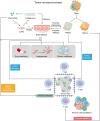Extracellular matrix stiffness and tumor-associated macrophage polarization: new fields affecting immune exclusion
- PMID: 38693304
- PMCID: PMC11063025
- DOI: 10.1007/s00262-024-03675-9
Extracellular matrix stiffness and tumor-associated macrophage polarization: new fields affecting immune exclusion
Abstract
In the malignant progression of tumors, there is deposition and cross-linking of collagen, as well as an increase in hyaluronic acid content, which can lead to an increase in extracellular matrix stiffness. Recent research evidence have shown that the extracellular matrix plays an important role in angiogenesis, cell proliferation, migration, immunosuppression, apoptosis, metabolism, and resistance to chemotherapeutic by the alterations toward both secretion and degradation. The clinical importance of tumor-associated macrophage is increasingly recognized, and macrophage polarization plays a central role in a series of tumor immune processes through internal signal cascade, thus regulating tumor progression. Immunotherapy has gradually become a reliable potential treatment strategy for conventional chemotherapy resistance and advanced cancer patients, but the presence of immune exclusion has become a major obstacle to treatment effectiveness, and the reasons for their resistance to these approaches remain uncertain. Currently, there is a lack of exact mechanism on the regulation of extracellular matrix stiffness and tumor-associated macrophage polarization on immune exclusion. An in-depth understanding of the relationship between extracellular matrix stiffness, tumor-associated macrophage polarization, and immune exclusion will help reveal new therapeutic targets and guide the development of clinical treatment methods for advanced cancer patients. This review summarized the different pathways and potential molecular mechanisms of extracellular matrix stiffness and tumor-associated macrophage polarization involved in immune exclusion and provided available strategies to address immune exclusion.
Keywords: Cancer-associated fibroblasts; Extracellular matrix stiffness; Immune exclusion; Tumor microenvironment; Tumor-associated macrophage.
© 2024. The Author(s).
Conflict of interest statement
The authors declare that they have no conflicts of interest.
Figures
Similar articles
-
Macrophage polarization in the tumor microenvironment: Emerging roles and therapeutic potentials.Biomed Pharmacother. 2024 Aug;177:116930. doi: 10.1016/j.biopha.2024.116930. Epub 2024 Jun 14. Biomed Pharmacother. 2024. PMID: 38878638 Review.
-
Natural plant-derived polysaccharides targeting macrophage polarization: a promising strategy for cancer immunotherapy.Front Immunol. 2024 Sep 16;15:1408377. doi: 10.3389/fimmu.2024.1408377. eCollection 2024. Front Immunol. 2024. PMID: 39351237 Free PMC article. Review.
-
Macrophage Polarization States in the Tumor Microenvironment.Int J Mol Sci. 2021 Jun 29;22(13):6995. doi: 10.3390/ijms22136995. Int J Mol Sci. 2021. PMID: 34209703 Free PMC article. Review.
-
Strategies to reprogram anti-inflammatory macrophages towards pro-inflammatory macrophages to support cancer immunotherapies.Immunol Lett. 2024 Jun;267:106864. doi: 10.1016/j.imlet.2024.106864. Epub 2024 May 3. Immunol Lett. 2024. PMID: 38705481 Review.
-
MicroRNAs: As Critical Regulators of Tumor- Associated Macrophages.Int J Mol Sci. 2020 Sep 27;21(19):7117. doi: 10.3390/ijms21197117. Int J Mol Sci. 2020. PMID: 32992449 Free PMC article. Review.
Cited by
-
Mechanosensitive ion channel-related genes in hepatocellular carcinoma: Unraveling prognostic genes and their roles in drug resistance and immune modulation.Liver Res. 2025 Jan 20;9(1):36-48. doi: 10.1016/j.livres.2025.01.002. eCollection 2025 Mar. Liver Res. 2025. PMID: 40206431 Free PMC article.
-
Comprehension of PTEN-Regulated MicroRNA Profiling in Oral Premalignant Lesions: A Critical Link to Early Detection of Oral Squamous Cell Carcinoma.Cureus. 2025 Apr 16;17(4):e82343. doi: 10.7759/cureus.82343. eCollection 2025 Apr. Cureus. 2025. PMID: 40385769 Free PMC article. Review.
-
CaMKK2 Regulates Macrophage Polarization Induced by Matrix Stiffness: Implications for Shaping the Immune Response in Stiffened Tissues.Adv Sci (Weinh). 2025 Apr;12(16):e2417778. doi: 10.1002/advs.202417778. Epub 2025 Mar 4. Adv Sci (Weinh). 2025. PMID: 40036145 Free PMC article.
-
Immune profiling of gastric adenocarcinomas in EU and LATAM countries identifies global differences in immune subgroups and microbiome influence.Br J Cancer. 2025 May;132(9):783-792. doi: 10.1038/s41416-025-02979-6. Epub 2025 Mar 20. Br J Cancer. 2025. PMID: 40113862 Free PMC article.
-
Metabolic Reprogramming of Cancer-Associated Fibroblast in the Tumor Microenvironment: From Basics to Clinic.Clin Med Insights Oncol. 2024 Oct 21;18:11795549241287058. doi: 10.1177/11795549241287058. eCollection 2024. Clin Med Insights Oncol. 2024. PMID: 39450056 Free PMC article. Review.
References
Publication types
MeSH terms
Grants and funding
LinkOut - more resources
Full Text Sources
Medical


